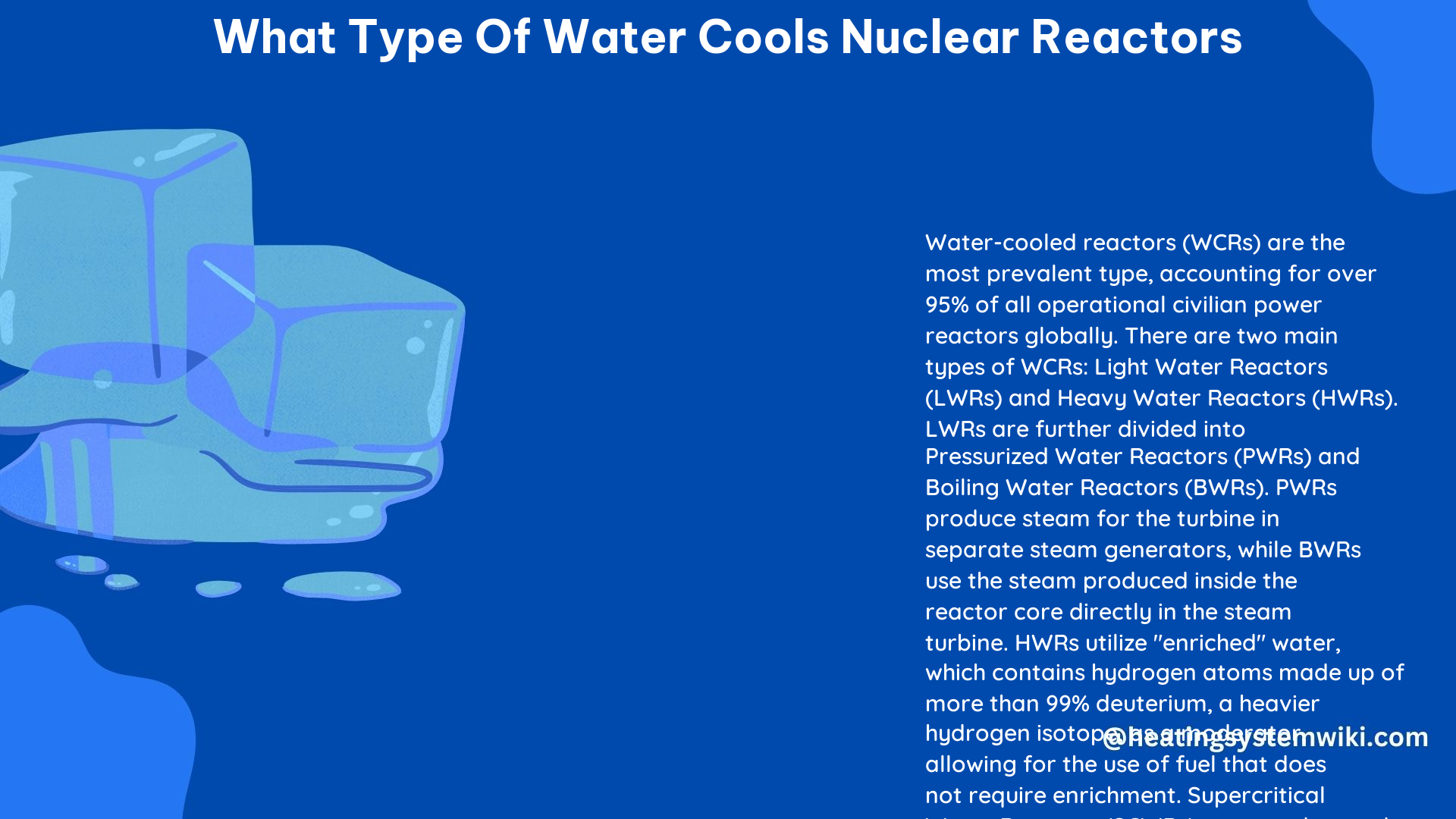Nuclear reactors require a reliable and efficient cooling system to maintain safe operating temperatures and prevent the core from overheating. The type of water used to cool nuclear reactors is a critical factor in the design and operation of these facilities. In this comprehensive guide, we will delve into the various types of water used for cooling nuclear reactors, their characteristics, and the advantages and disadvantages of each.
Light Water Reactors (LWRs)
The most common type of water used to cool nuclear reactors is light water, which is chemically similar to the water found in nature. Light water reactors (LWRs) are the predominant type of nuclear power plants worldwide, accounting for over 90% of the global reactor fleet.
Pressurized Water Reactors (PWRs)
Pressurized Water Reactors (PWRs) are the most widely used type of LWRs, with over 300 units in operation globally. In a PWR, the primary cooling circuit flows through the reactor core, where the water is heated to high temperatures, typically around 315°C (600°F). To prevent the water from boiling, the primary circuit is maintained at a high pressure, typically around 15.5 MPa (2,250 psi).
- The high pressure in the primary circuit allows the water to remain in a liquid state, even at the high temperatures.
- The heated water in the primary circuit is then used to generate steam in a secondary circuit, which drives the turbine generator to produce electricity.
- PWRs use enriched uranium as the fuel, typically with a uranium-235 content of around 3-5%.
Boiling Water Reactors (BWRs)
Boiling Water Reactors (BWRs) are the second most common type of LWRs, with over 80 units in operation globally. In a BWR, the water in the reactor core is allowed to boil, generating steam that is directly fed to the turbine generator.
- The water in the BWR reactor core is held at a lower pressure, typically around 7 MPa (1,000 psi), which allows it to boil at the operating temperatures.
- The steam generated in the reactor core is then used to directly drive the turbine generator, without the need for a secondary circuit.
- BWRs also use enriched uranium as the fuel, typically with a uranium-235 content of around 3-5%.
Heavy Water Reactors (HWRs)

Heavy Water Reactors (HWRs) use a chemically distinct type of water, known as heavy water, to cool and control the nuclear reactions. Heavy water, or deuterium oxide (D2O), is a stable isotope of water with a higher atomic mass than regular water.
- The use of heavy water allows HWRs to use natural, unenriched uranium as the fuel, rather than the enriched uranium required in LWRs.
- HWRs operate at lower pressures compared to LWRs, typically around 10 MPa (1,450 psi).
- The heavy water in HWRs acts as both a coolant and a moderator, slowing down the neutrons to sustain the nuclear chain reaction.
- Examples of HWRs include the CANDU (Canada Deuterium Uranium) reactors, which are widely used in Canada, India, and other countries.
Advanced Water-Cooled Reactors
In addition to the traditional LWRs and HWRs, there are also advanced types of water-cooled reactors being developed to improve efficiency and safety.
Supercritical Water Reactors (SCWRs)
Supercritical Water Reactors (SCWRs) are a type of advanced water-cooled reactor that operate at higher temperatures and pressures than conventional LWRs.
- SCWRs use supercritical water, which is water above its critical point (374°C and 22.064 MPa), as the coolant.
- The use of supercritical water allows for higher thermal efficiencies, typically around 45-50%, compared to 33-35% for conventional LWRs.
- SCWRs can also use a wider range of fuel types, including enriched uranium, thorium, and mixed oxide (MOX) fuels.
- The development of SCWRs is an active area of research, with several countries, including Canada, China, and the European Union, working on prototype designs.
Other Coolant Options
While water is the most common coolant used in nuclear reactors, there are ongoing research and development efforts exploring the use of other coolants, such as:
- Liquid Metals:
- Sodium-cooled fast reactors (SFRs) use liquid sodium as the coolant.
-
Lead-cooled fast reactors (LFRs) use liquid lead or lead-bismuth eutectic as the coolant.
-
Molten Salts:
-
Molten Salt Reactors (MSRs) use a molten salt, such as a mixture of fluoride salts, as the coolant and fuel.
-
Gases:
- Gas-cooled reactors (GCRs) use gases, such as helium or carbon dioxide, as the coolant.
These alternative coolant options offer the potential for improved safety, efficiency, and fuel utilization, but they also come with their own unique challenges and requirements.
In conclusion, the type of water used to cool nuclear reactors is a critical factor in the design and operation of these facilities. Light water reactors, including Pressurized Water Reactors (PWRs) and Boiling Water Reactors (BWRs), are the most common, while Heavy Water Reactors (HWRs) use a chemically distinct type of water. Additionally, advanced water-cooled reactor designs, such as Supercritical Water Reactors (SCWRs), are being developed to improve efficiency and safety. The choice of coolant is an ongoing area of research and development, with various alternatives, including liquid metals, molten salts, and gases, being explored to further enhance the capabilities of nuclear power.
References:
- Water Cooled Reactor – an overview | ScienceDirect Topics
- Cooling Power Plants – World Nuclear Association
- Water cooled nuclear reactors (WCR) | IAEA
- Supercritical Water Reactors (SCWRs) | Generation IV International Forum
- Liquid Metal Cooled Reactors | Generation IV International Forum
- Molten Salt Reactors | Generation IV International Forum
- Gas-Cooled Reactors | Generation IV International Forum
